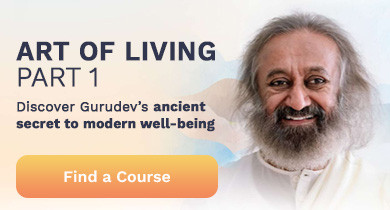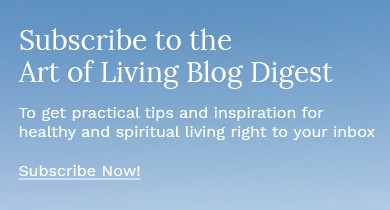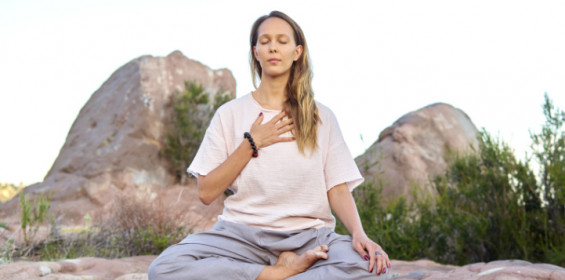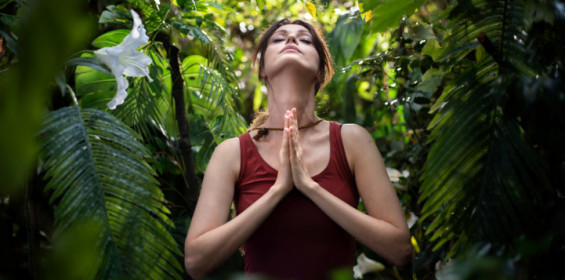
For a quick way to find your center, try Bhramari Pranayama. It can help you feel calm and collected in just minutes.
This breathing technique (pranayama) gets its name from the black Indian bee called Bhramari. The exhalation in this pranayama mimics a bee's buzz. That's why it's often called humming bee breath.
Keep reading to learn more about pranayama and all the specifics you need to know to practice Bhramari Pranayama.
Introduction to pranayama practice
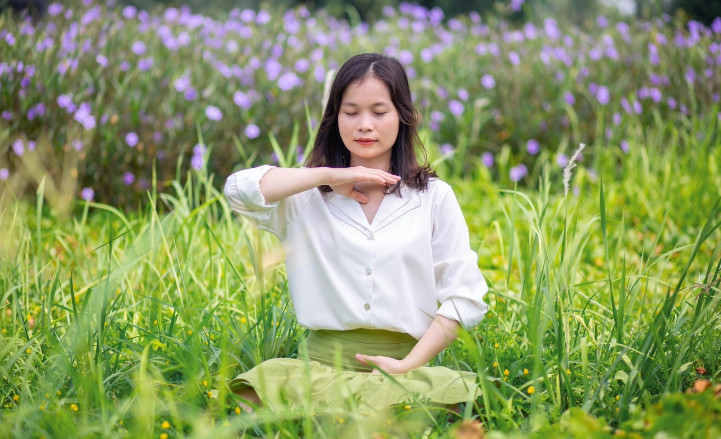
Pranayama is a Sanskrit word that can be divided into two words: prana and yama. Prana refers to the subtle life energy, and yama means to control. Breathing in and out in specific ways, often to specific counts, is one way to control your breath for various benefits.
Breathing techniques, such as Bhramari Pranayama, help you relax. They also manage emotional stress and lower anxiety.
Regular practice of pranayama can lead to significant improvements in mental health and overall well-being.
Understanding the humming sound

In Bhramari Pranayama, a high-pitched hum is produced. It resonates throughout the throat and chest. It is created by the vocal cords' vibration and the movement of the breath through the nasal passages.
The humming sound affects the autonomic nervous system, decreasing sympathetic nervous system activity (fight or flight) and increasing parasympathetic nervous system activity (rest and digest).
Benefits of Humming Bee Breathing

Bhramari Pranayama improves pulmonary function, including increased peak expiratory flow rate and maximal voluntary ventilation. It can also help reduce symptoms of chronic obstructive pulmonary disease (COPD).
A daily practice of Bhramari Pranayama can significantly reduce blood pressure and improve cardiovascular health. However, Bhramari Pranayama is not a substitute for medication. Always seek the advice of your healthcare provider when considering changes to prescribed medications.
Here’s a short list of other benefits from a regular practice of Humming Bee Breath.
Instant relief of tension and anxiety
Calms down an agitated mind
Has a cooling effect if you’re hot
Can relieve slight headaches
Reduces and helps prevent anger
Helps mitigate migraines
Improves concentration and memory
Helps in lowering blood pressure
Helps manage emotional stress
Promotes overall well-being
Bhramari Pranayama’s impact on cardiovascular functions

Bhramari pranayama helps manage stress and anxiety. These are key risk factors for heart disease. It has been shown to positively impact cardiovascular functions, including decreased blood pressure and improved cardiac output. Humming Bee Breath can also significantly reduce cardiovascular hyperreactivity and improve cardiovascular health. When practiced regularly, Bhramari Pranayama can substantially improve stroke volume and decrease pulse pressure.
Bhramari Pranayama and pulmonary functions

Bhramari Pranayama practice has also been shown to positively impact pulmonary functions, including increased peak expiratory flow rate and maximal voluntary ventilation.
The practice of Bhramari Pranayama can significantly improve slow vital capacity and increase forced vital capacity.
Bhramari Pranayama may reduce symptoms of chronic obstructive pulmonary disease (COPD). It can also enhance your overall well-being.
Contraindications for Bhramari Pranayama

Once you learn Bhramari Pranayama well, anyone can do it. This includes children and older adults. There are a few exceptions, though.
Bhramari Pranayama should not be practiced by menstruating or pregnant women. It is also not recommended for those with very high blood pressure, epilepsy, chest pain, or an ongoing ear infection. Bhramari Pranayama should not be practiced in a supine position (lying down).
How to practice Bhramari Pranayama

Before deep breathing, wait at least two hours after eating. It's best to have an empty stomach.
Sit comfortably with a straight back in a quiet, well-ventilated space. Gently close your eyes, and keep a gentle smile on your face.
Place your index fingers on your ears. There’s cartilage between your cheek and ear. Place your index fingers on this cartilage.
Take a deep breath in, and as you exhale, make a humming sound like a bee, gently pressing the cartilage. You can keep the cartilage pressed, or push it in and out with your fingers.
You can make a low-pitched sound or a high-pitched one.
Inhale again, and repeat the pattern five to nine times.
Keep your eyes closed for some time. Observe the sensations in the body and the quietness within. You may want to sit for meditation.
You can practice bee breath three to nine times every day.
If you need further help to learn Bhramari Pranayama, watch this video.
Variations of Bhramari Pranayama

Bhramari pranayama comes in several forms. You can try different hand positions and breathing techniques.
To enhance your experience, you can keep your fingers in Shanmukhi Mudra, a hand position, while doing this Bhramari Pranayama.
Hand position 1
Gently place your thumbs on the ear cartilage. Place your index fingers on your eyes. Place your middle fingers on your nostrils and ring fingers above your upper lip. Place your little fingers below your lower lip.
For more clarity, this video demonstrates the Shanmukhi Mudra variation.
Hand position 2
Alternatively, place your thumbs on the ear cartilage, index fingers on the forehead just above your eyebrows, middle fingers on your eyes, ring fingers on your nostrils, and pinky fingers just next to the corners of your lips.
Sound variation
Bhramari Pranayama can be practiced with either a high-pitched or low-pitched hum. Higher pitches could be more energizing, while lower pitches tend to be more calming.
Bonus tip
Add Humming Bee Breath before your yoga practices to experience deeper meditative states.
Beyond Bhramari Pranayama
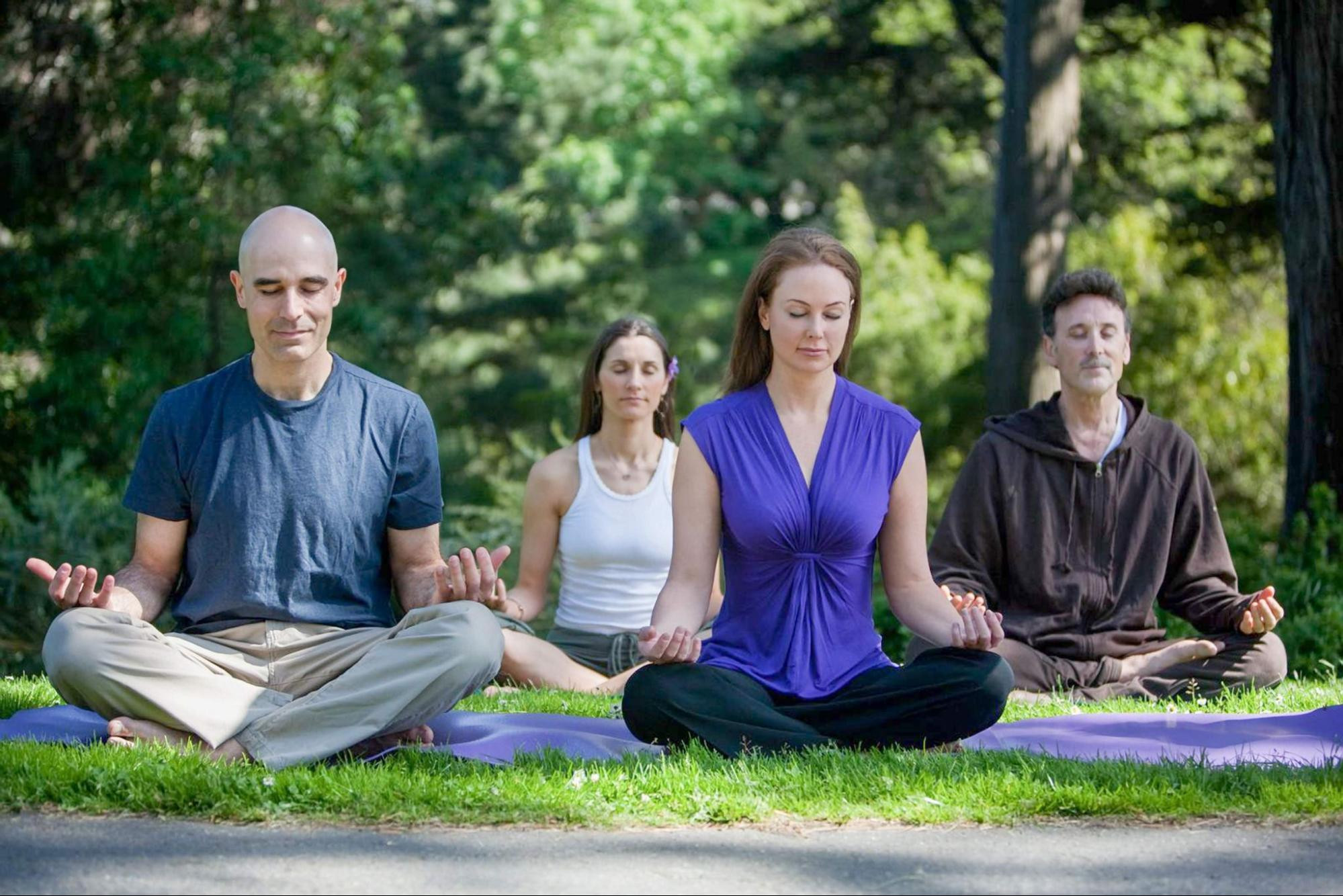
Want even more benefits from a breathing practice? SKY Breath Meditation is an evidence-based practice that uses the power of your breath for deep meditation. SKY is easy to learn and simple to practice. SKY practitioners report healthier blood pressure, a significant reduction in stress, better sleep, and more.
To experience SKY for yourself, register for the Art of Living Part 1 course here.
Related articles

Pranayama Benefits: Improve Your Whole Life with Breathing!
Learn Pranayama Breath Control and Its Positive Effects on Your Health
Alternate Nostril Breathing: Balance Your Mind and Emotions
Ujjayi Breathing for Yoga, Meditation, and Better Sleep
Bhastrika Pranayama: A Breathing Cleanse To Help You Meditate
Kapalbhati Pranayama: Breathe Your Way to Weight Loss
Conscious Breathing: What Is It?
Pranayama Breathing Can Spark Your Creative Fire: Try These 4 Today
Pranayama in Yoga: The Top 3 Reasons to Try Yogic Breathing Exercises

